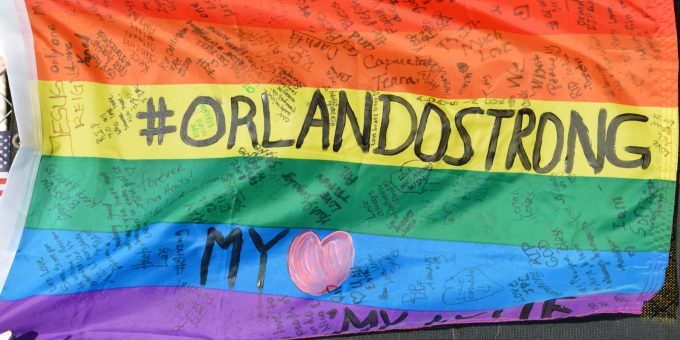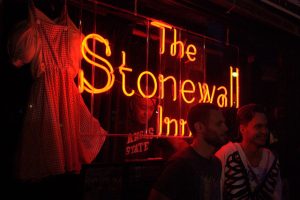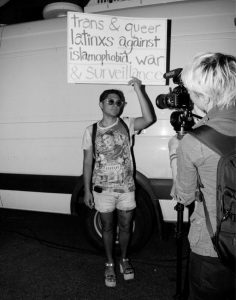
[This piece is an excerpt from the book I’m writing on changes in gay bars.]
In 2016, two gay bars became national monuments, one in the early hours of June the 12th in Orlando, Florida. The way we learned of the attack through news and social media, and the stories that emerged in the aftermath, dramatized the degree to which LGBTQ social life and social media are deeply enmeshed, and the divisions and exclusions within the LGBTQ community. In particular, the first 24 hours of the attack revealed the divisions between English-language media and LGBTQ people and queers who are Latinx.
In the aftermath of the massacre at Orlando’s Pulse nightclub, national mainstream publications featured an extraordinary outpouring of pieces on gay bars and clubs. Mathew Rodriguez linked the tragedy in Florida to the symbolic origin of the LGBT rights movement in New York City, saying, “Like the Stonewall Inn, Pulse now serves as a brick-and-mortar monument to queer resilience.” Thus, the histories of two monuments became enmeshed in a contemporary question: what is the meaning and purpose of gay places? The contemporaneous accounts on social media, and the reaction pieces in mainstream media, reveal how enmeshed queer lives are with both physical places and virtual spaces.
12 midnight, comment on Periscope broadcast from Pulse Nightclub by José Morales
“I hope that place gets shot up”—@n_eeks
2:06am, SMS text messages to Mina Justice
“Mommy I love you
In club they shooting”—Eddie Jamoldroy Justice
2:09am, Facebook
“Everyone get out of pulse and keep running”—Pulse Orlando
2:39am, text messages
“He’s coming
I’m gonna die”—Eddie Jamoldroy Justice
2:42am, Twitter
“#pulse, the new #stonewall” —@DonnieHinkle
2:53am, Twitter
“Pulse Shooting: The shooter inside the club is dead”—@OrlandoPolice
5:54am, Twitter
“Every shooting hurts, but a shooting at a Latino night at a gay bar during Immigrant Heritage Month and Pride Month stings a salty sting”—@mathewrodriguez
11:06am, Univision
“Pulse celebraba su tradicional “noche latina” en una ciudad donde el 24% de sus 2.4 millones de habiantes es hispano… La población hispana en Orlando ha crecido fuertemente en los últimos años, especialmente en medio de la oleada de puertorriqueños que ha abandonado la isla por la aguda crisis económica.”—Univision Noticias
11:40am, Facebook
“All Orlando nightclubs should be permanently closed. With or without random gunmen they are zoos,; utter cesspools of debauchery.”—Florida Assistant State Attorney Kenneth Lewis
12:03pm, The Guardian
“For generations, gay, lesbian, bisexual and transgender Americans have turned to night clubs and bars like Orlando’s Pulse—the scene today of the deadliest shooting in American history—as places of refuge. They have been our sanctuaries”—Steven W. Thrasher
1:59pm The White House
“The place where they were attacked is more than a nightclub—it is a place of solidarity and empowerment where people have come together to raise awareness, to speak their minds, and to advocate for their civil rights”—Barack Obama
4:03pm, Twitter
“Would the immediate closing of all gay bars help ease any uncomfortable feelings felt by arriving refugee immigrants? Gays could use alleys.” —@RaesmaC [account since deleted]
4:24pm, Slate Magazine
“On Friday night, we felt safe, confident in the still-rare sense of total freedom—from evil eyes, from family friendly etiquette, from people who might want to kill us—that this space, the gay bar, afforded. On Saturday night, that confidence was broken… At least 50 of my family members are dead”—J. Bryan Lowder
6:56pm PBS Newshour
Hours after at least 50 people were killed in a shooting in a gay club in Orlando—the LGBT community and its allies gathered to pay tribute at The Stonewall Inn…[It] has been the symbolic heart of the American gay community for decades, ever since protesters led by transgender women of color clashed with cops who raided the bar. This month, it was announced that the bar, already a National Historic Landmark, is poised to become the first LGBT National Monument.”—Omar Etman and Daniel Mortiz-Rabson
7:20pm USA Today
“…Her brother died from AIDS. Barbara Poma opened Pulse on Orange Avenue with friend and co-founder Ron Legler in 2004. It hosts nightly themed performances as well as a monthly program of LGBT-related educational events… ‘[we] coined the name Pulse for John’s heartbeat—as a club that is John’s inspiration, where he is kept alive in the eyes of his friends and family’”—Kim Hjelmsgaard
8:48pm New York Times
“‘Gay bars and clubs are supposed to be our safe haven,’ said Mr. Milack-Carrasco, 48, a store manager from Brooklyn. ‘I’ve never felt threatened here [at the Stonewall Inn], but now I’m looking over my shoulder.’ Ever since the 1969 rebellion, Stonewall has become the locus not only for gay, lesbian, bisexual and transgender New Yorkers, but also for people across the country and the world who crave the sense of belonging that is still not easy to find in many places.”—Noah Remnick
Explaining gay bars for mainstream audiences, gay writers, some of them making their first appearance in such big-name outlets, rhapsodized about safe havens, liberating refuges, sanctuaries — a metaphorical archipelago where any bar was every gay person’s home, and all fellow bargoers were part of one big queer family. For example, J. Bryan Lowder, associate editor for Slate Magazine’s LGBT beat, described the dead as his family members, and characterized the unnamed gay club he was in during the assault by saying, “To say that I went home afterward is misleading: I was already there.”
As a professional gay bar researcher and amateur gay-bar-goer, these breathless descriptions left me discomfited. Gay bars haven’t been the center of gay life for decades, and have been going out of business in record numbers in recent years. By my measurements, about one-third of America’s gay bars have closed since 2008 with few new ones replacing them, adding a dissonant note to descriptions of their centrality to gay life. LGBT journalists have noticed, even if few straight ones have, in stories entitled: “RIP Gay Bars,” “Goodbye to All the Gay Bars,” and “The Gay Bar: Is it Dying?” If bars are our sanctuaries, than the congregation has not had their butts in the pews for a while, perhaps part of what sociologist Amin Ghaziani describes as a shift from gay urban enclaves to suburban “post-gays.” With 49 newly dead, however, June 12th, 2016 was not the time to eulogize gay bars as well.

The post-Orlando effusions predictably noted the importance of the Stonewall Inn, an icon raised to the status of National Monument by President Obama only two weeks after the attacks. Almost always described as the origin of the gay rights movement, sociologists Elizabeth Armstrong and Suzanna Crage have shown that among many other previous gay protests, the commemoration of this particular riot was “an achievement of gay liberation [activism] rather than an account of its origins.” Similarly, few writers noted the centrality of bars in general to shaping America’s gay civil rights movement as we know it. As gay historian John D’Emilio wrote in 1983, “bars proved themselves to be repositories of political consciousness and places from which gay anger erupted.” But D’Emilio also documented the centrism of bar politics, tied as it was to the goodwill of paying patrons and civic authorities. This meant that if gay bars were not reactionary or apolitical, they were also never the centers of queer radicalism. For good or ill, the contemporary centrist, gay bar politics incubated the assimilationist character of contemporary gay politics in America.
The Orlando attack was framed by many as another attack on America by an outsider, despite Omar Mateen’s American birth and upbringing: Twitter commenters such as the now-deleted @RaesmaC described him as a “refugee” or “immigrant,” and blamed the attack on accommodating his “uncomfortable feelings.” I shared the growing frustration of my Latinx peers at lack of media coverage about the attack being on Latin Night at Pulse, where many of the victims were actual immigrants and economic refugees. The coverage was a textbook case of the difficulty of asserting a complex media narrative about the attack—at least in English language mainstream media.
Social media and Spanish-language media, however, presented more complex views. Three hours after the attack, Twitter user Mathew Rodriguez noted the painful juxtaposition of an attack during Immigrant Pride month and LGBT Pride Month. But despite journalists’ reliance on Twitter for their reportage, his insight was not repeated in English-language news, nor were the eerie comments on a Periscope broadcast that presaged the shooting — both issues that were covered in Spanish-language news.

As “We are Orlando” spread outwards, Latinx writers issued increasingly insistent reminders that this was not just a gay tragedy. Sociologist Salvador Vidal-Ortiz addressed “white hetero” liberals, saying, “You never left that comfort, you just thought about ‘those’ killed. But it was ‘Latino night’ at a gay club. I do not have that luxury. I carry its weight with me.” Novelist Justin Torres wrote in “In Praise of Latin Night at the Queer Club” for the Washington Post, “You have known violence. You have known violence. You are queer and you hare brown and you have known violence.” He linked this violence against queer Latinx bodies to Christian homophobia, Puerto Rican debt colonialism, and more than 100 pending legislative actions targeting Latino immigrants. None of these connections were made by English-language journalists. Only nine hours after the attack, however, Spanish-language Univision had provided context unmatched in detail by any subsequent English-language outlet:
“Pulse celebrated its traditional ‘Latin night’ in a city where 24% of its 2.4 million inhabitants is Hispanic… Orlando’s Hispanic population has increased sharply in recent years, especially amid the wave of Puerto Ricans who have left the island because of the acute economic crisis.”
The adoption of Pulse as a monument to attacks on America by outsiders, as “our Stonewall” for all LGBTQ people, erases the ways that Latinx queers were themselves outsiders. This is shown in the hundreds of state legislative actions against immigrants, and through bills aimed at LGBT people more generally that are often enforced disproportionately against people of color — attempts to ban transgender people from public restrooms and national proposals to legalize discrimination against LGBT people, to name a few examples. “We” white and cisgendered LGBT people can choose to “be” Orlando in these situations that are less likely to affect us. As Vidal-Ortiz reminds us, many Latinx have no choice but to bear the weight of “Queer-Orlando-América,” that place where solidarity cannot erase the inequalities of the surveillance state, transphobia, and xenophobia.
The promise of LGBTQ places is the possibility of a solidarity across social divisions. If we rarely experience this in person, listening across these divisions on social media is one place to hear a richer chorus of voices, and the meanings of our places, to LGBTQ people—all of us, not just white liberals—in the contemporary United States.
Recommended Readings
Elizabeth A. Armstrong and Suzanna M. Crage. 2006. “Movements and Memory: The Making of the Stonewall Myth.” American Sociological Review 71(5).
John D’Emilio. 1992. Making Trouble: Essays On Gay History, Politics, and the University. New York: Routledge.
Amin Ghaziani. 2015. There Goes the Gayborhood? Princeton University Press.
Greggor Mattson. 2015. “Style and the Value of Gay Nightlife: Homonormative Placemaking in San Francisco.” Urban Studies 52(16).
June Thomas. 2011. “The Gay Bar: It’s Riotous Past and Uncertain Future.” Slate Magazine.
Salvador Vidal-Ortiz. 2016. “Queer-Orlando-América.” Feminist Reflections.
